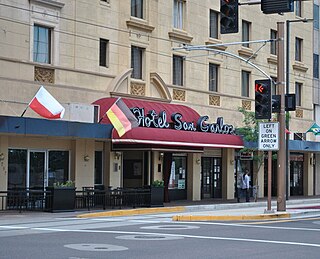
The Hotel San Carlos branch in Phoenix, Arizona, also known as San Carlos Hotel, is both an operating hotel and tourist site. It has been associated with ghost sightings. It was listed on the National Register of Historic Places (NRHP) in 1983 as San Carlos Hotel. Hotel San Carlos is a member of Historic Hotels of America, the official program of the National Trust for Historic Preservation
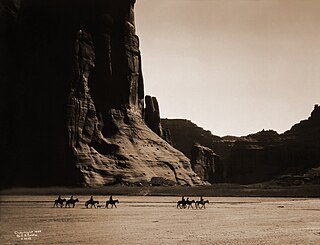
Canyon de Chelly National Monument was established on April 1, 1931, as a unit of the National Park Service. Located in northeastern Arizona, it is within the boundaries of the Navajo Nation and lies in the Four Corners region. Reflecting one of the longest continuously inhabited landscapes of North America, it preserves ruins of the indigenous tribes that lived in the area, from the Ancestral Puebloans to the Navajo. The monument covers 83,840 acres and encompasses the floors and rims of the three major canyons: de Chelly, del Muerto, and Monument. These canyons were cut by streams with headwaters in the Chuska Mountains just to the east of the monument. None of the land is federally owned. Canyon de Chelly is one of the most visited national monuments in the United States.

This is a directory of properties and districts listed on the National Register of Historic Places in Arizona. There are about fourteen hundred listed sites in the state, and each of its fifteen counties has at least ten listings on the National Register. Forty-seven of the state's sites are further designated as National Historic Landmarks.

Yuma Crossing is a site in Arizona and California that is significant for its association with transportation and communication across the Colorado River. It connected New Spain and Las Californias in the Spanish Colonial period in and also during the Western expansion of the United States. Features of the Arizona side include the Yuma Quartermaster Depot and Yuma Territorial Prison. Features on the California Side include Fort Yuma, which protected the area from 1850 to 1885.
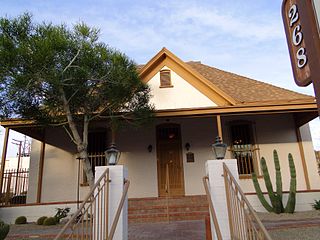
The Brown House is a 19th-century house in Yuma, Arizona, built of brick in the 1890s.

This is a list of the National Register of Historic Places listings in Yuma County, Arizona. It is intended to be a complete list of the properties and districts on the National Register of Historic Places in Yuma County, Arizona, United States. The locations of National Register properties and districts for which the latitude and longitude coordinates are included below, may be seen in a map.

El Camino del Diablo, also known as El Camino del Muerto, Sonora Trail, Sonoyta-Yuma Trail, Yuma-Caborca Trail, and Old Yuma Trail, is a historic 250-mile (400 km) road that passes through some of the most remote and inhospitable terrain of the Sonoran Desert in Pima County and Yuma County, Arizona. The name refers to the harsh, unforgiving conditions on the trail.
The Southern Pacific Railroad Depot in Yuma, Arizona, was built as a Spanish Colonial Revival-style station by the Southern Pacific Railroad in 1926.
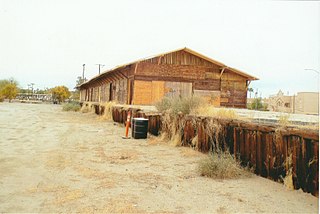
Southern Pacific Freight Depot in Yuma, Arizona was built in 1891, built with redwood shiplap and in the wooden Stick—Eastlake architectural motifs of the Victorian Queen Anne Style.

The Masonic Temple in Yuma, Arizona, was built in 1931 in the late Art Deco style of Moderne. It was designed by Los Angeles–based architects Edward Gray Taylor and Ellis Wing Taylor. In 1933, at the depth of the Great Depression, the Masonic lodge lost all its funds in a bank closure. On November 16, 1933, the building's ownership was turned over to the Pacific Mutual Life Insurance Company "in satisfaction of a $16,900 realty mortgage." It was later rented back to the Masonic chapter and on May 10, 1940, ownership was restored.
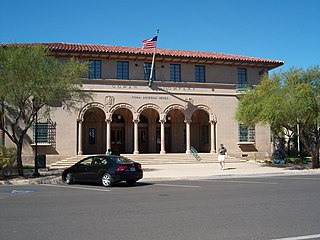
The Gowan Company Building, formerly known as the Yuma Main Post Office or Yuma Downtown Postal Annex, is a historic building in Yuma, Arizona. Constructed in 1933 to serve as the city's main post office, the building's design, a work of architect Roy Place, is a blend of the Beaux Arts and Spanish Colonial Revival styles. The design includes a loggia supported by Corinthian columns, wrought iron railings and window bars, a molded belt course between the building's two stories, a projecting bracketed cornice, and a red tile roof. The post office was built toward the end of the Beaux-Arts phase of federal building design, as government architects shifted to a "starved classicism" style in the ensuing years.
Norman Foote Marsh was an American architect based in Los Angeles, California who worked mostly in California and Arizona.
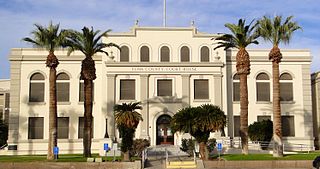
The Yuma County Courthouse is a historic building in Yuma, Arizona. It is the third building to serve as the courthouse of Yuma County, Arizona. It was built in 1928, and designed by Ralph Swearingen & G. A. Hanssen, two architects from San Diego, California. It has been listed on the National Register of Historic Places since December 7, 1982.

The Yuma City Hall is a historic building in Yuma, Arizona. It was built in 1921, and it served as Yuma's city hall for many years. It was designed by Lyman & Place in the Spanish Colonial Revival architectural style. It has been listed on the National Register of Historic Places since December 7, 1982.

The San Carlos Hotel is a historic hotel in Yuma, Arizona. Its construction cost $300,000, and it was completed in 1930. It was five stories high, with 107 bedrooms. It was remodelled into 59 residential apartments in the 1980s.
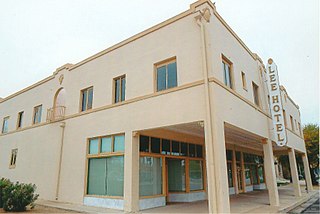
The Lee Hotel is a “haunted” historic hotel in Yuma, Arizona. It is a two-story building, with 30 hotel rooms, completed in 1917. It was opened by Mary Darcy, who named it for Confederate General Robert E. Lee. It was designed in the Spanish Colonial Revival architectural style. It has been listed on the National Register of Historic Places since April 12, 1984.
Gustav A. Hanssen was an American architect. He designed private residences in Davenport, Iowa and later moved to San Diego, California. Several of his buildings are listed on the National Register of Historic Places (NRHP).
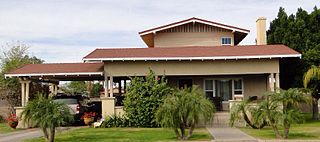
The J. Homer Smith is a historic house in Yuma, Arizona. It was built in 1917 for J. Homer Smith, a druggist and banker who served as the mayor of Yuma. He later moved to Tucson, and he died in 1936. The house was designed in the American Craftsman architectural style. It has been listed on the National Register of Historic Places since December 7, 1982.
















